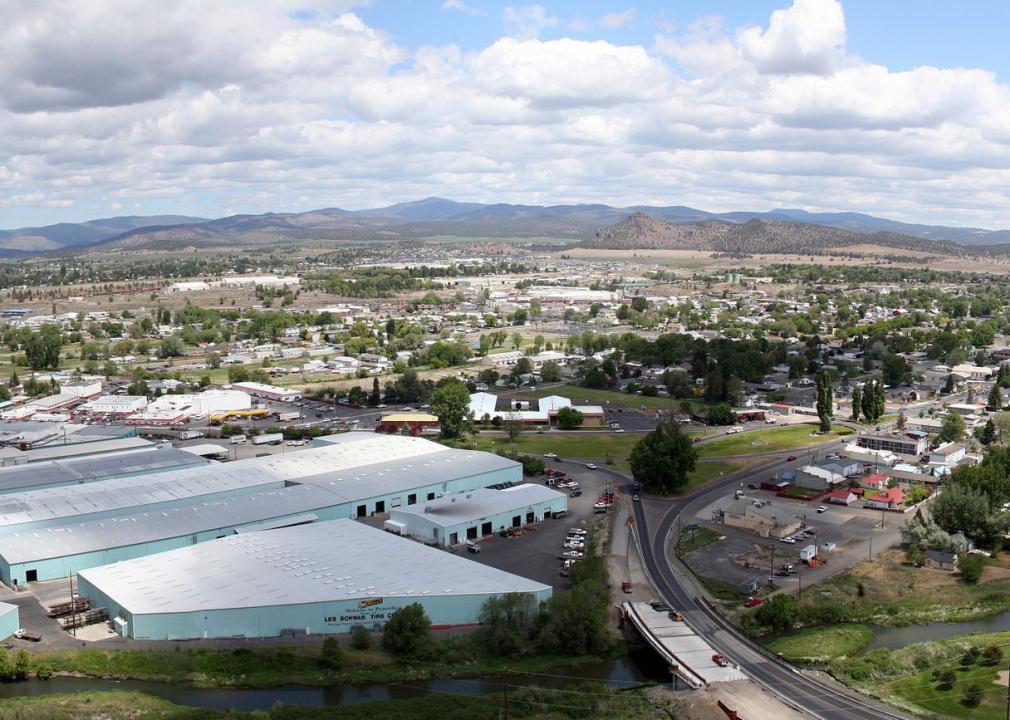Counties with the highest rate of food insecurity in Oregon
Finetooth // Wikimedia Commons
Counties with the highest rate of food insecurity in Oregon
Every county in the United States is home to people experiencing food insecurity, defined by the nonprofit Feeding America as “a lack of consistent access to enough food for every person in a household to live an active, healthy life.”
The USDA estimates that 89.5% of U.S. households were food secure throughout 2019—that’s 116.0 million people. The COVID-19 pandemic put further strain on households already experiencing food hardship, with Feeding America estimating that 42 million people, or 1 in 8 Americans, may experience food insecurity in 2021. This is a slight improvement from 2020 numbers but still represents an enormous burden for millions of children and adults.
Stacker compiled a list of counties in Oregon with the highest rate of food insecurity using data from Feeding America. Counties are ranked by highest percent of population with food insecurity as of 2019.
Sam Beebe // Wikimedia Commons
#36. Hood River County
– Food insecurity rate: 6.6% (1,540 total)
— 39.4% lower than national average
– Child food insecurity rate: 7.7% (430 total)
— 47.3% lower than national average
– Annual food budget shortfall: $996,000
— Cost per meal: $3.78
Mrgadget51 // Wikimedia Commons
#35. Clackamas County
– Food insecurity rate: 8.4% (34,620 total)
— 22.9% lower than national average
– Child food insecurity rate: 10.4% (9,300 total)
— 28.8% lower than national average
– Annual food budget shortfall: $21,029,000
— Cost per meal: $3.55
M.O. Stevens // Wikimedia Commons
#34. Washington County
– Food insecurity rate: 8.4% (49,270 total)
— 22.9% lower than national average
– Child food insecurity rate: 10.0% (13,740 total)
— 31.5% lower than national average
– Annual food budget shortfall: $28,562,000
— Cost per meal: $3.39
Finetooth // Wikimedia Commons
#33. Morrow County
– Food insecurity rate: 10.2% (1,160 total)
— 6.4% lower than national average
– Child food insecurity rate: 16.0% (500 total)
— 9.6% higher than national average
– Annual food budget shortfall: $612,000
— Cost per meal: $3.09
M.O. Stevens // Wikimedia Commons
#32. Yamhill County
– Food insecurity rate: 10.2% (10,670 total)
— 6.4% lower than national average
– Child food insecurity rate: 14.3% (3,360 total)
— 2.1% lower than national average
– Annual food budget shortfall: $6,291,000
— Cost per meal: $3.45
Ian Poellet // Wikimedia Commons
#31. Deschutes County
– Food insecurity rate: 10.2% (19,030 total)
— 6.4% lower than national average
– Child food insecurity rate: 13.8% (5,240 total)
— 5.5% lower than national average
– Annual food budget shortfall: $11,627,000
— Cost per meal: $3.57
Bruce Fingerhood from Springfield, Oregon, US // Wikimedia Commons
#30. Polk County
– Food insecurity rate: 10.5% (8,740 total)
— 3.7% lower than national average
– Child food insecurity rate: 13.9% (2,630 total)
— 4.8% lower than national average
– Annual food budget shortfall: $4,934,000
— Cost per meal: $3.30
cpaulfell // Shutterstock
#29. Benton County
– Food insecurity rate: 10.8% (9,870 total)
— 0.9% lower than national average
– Child food insecurity rate: 12.1% (1,810 total)
— 17.1% lower than national average
– Annual food budget shortfall: $5,843,000
— Cost per meal: $3.46

Edmund Garman // Flickr
#28. Marion County
– Food insecurity rate: 11.2% (37,990 total)
— 2.8% higher than national average
– Child food insecurity rate: 15.0% (12,640 total)
— 2.7% higher than national average
– Annual food budget shortfall: $20,149,000
— Cost per meal: $3.10

Stuart Seeger // Wikicommons
#27. Multnomah County
– Food insecurity rate: 11.2% (89,810 total)
— 2.8% higher than national average
– Child food insecurity rate: 13.6% (20,830 total)
— 6.8% lower than national average
– Annual food budget shortfall: $55,798,000
— Cost per meal: $3.63
Cacophony // Wikimedia Commons
#26. Columbia County
– Food insecurity rate: 11.4% (5,840 total)
— 4.6% higher than national average
– Child food insecurity rate: 15.7% (1,720 total)
— 7.5% higher than national average
– Annual food budget shortfall: $3,709,000
— Cost per meal: $3.71
Cacophony // Wikimedia Commons
#25. Wasco County
– Food insecurity rate: 11.8% (3,080 total)
— 8.3% higher than national average
– Child food insecurity rate: 15.9% (930 total)
— 8.9% higher than national average
– Annual food budget shortfall: $1,973,000
— Cost per meal: $3.75
English: Gary Halvorson, Oregon State Archives // Wikimedia Commons
#24. Clatsop County
– Food insecurity rate: 11.8% (4,610 total)
— 8.3% higher than national average
– Child food insecurity rate: 13.6% (1,010 total)
— 6.8% lower than national average
– Annual food budget shortfall: $2,533,000
— Cost per meal: $3.21
Tedder // Wikimedia Commons
#23. Gilliam County
– Food insecurity rate: 12.1% (230 total)
— 11.0% higher than national average
– Child food insecurity rate: 14.0% (50 total)
— 4.1% lower than national average
– Annual food budget shortfall: $143,000
— Cost per meal: $3.64
Williamborg // Wikimedia Commons
#22. Union County
– Food insecurity rate: 12.5% (3,300 total)
— 14.7% higher than national average
– Child food insecurity rate: 17.5% (1,010 total)
— 19.9% higher than national average
– Annual food budget shortfall: $1,804,000
— Cost per meal: $3.20
USFWS Headquarters’ photostream // Wikimedia Commons
#21. Tillamook County
– Food insecurity rate: 12.7% (3,360 total)
— 16.5% higher than national average
– Child food insecurity rate: 18.5% (930 total)
— 26.7% higher than national average
– Annual food budget shortfall: $2,154,000
— Cost per meal: $3.75
Jmabel // Wikimedia Commons
#20. Linn County
– Food insecurity rate: 12.7% (15,860 total)
— 16.5% higher than national average
– Child food insecurity rate: 16.9% (4,790 total)
— 15.8% higher than national average
– Annual food budget shortfall: $8,441,000
— Cost per meal: $3.11

Little Mountain 5 // Wikicommons
#19. Jackson County
– Food insecurity rate: 12.7% (27,520 total)
— 16.5% higher than national average
– Child food insecurity rate: 17.5% (7,830 total)
— 19.9% higher than national average
– Annual food budget shortfall: $15,358,000
— Cost per meal: $3.26
Ken Lund // Wikimedia Commons
#18. Harney County
– Food insecurity rate: 12.8% (930 total)
— 17.4% higher than national average
– Child food insecurity rate: 17.4% (260 total)
— 19.2% higher than national average
– Annual food budget shortfall: $523,000
— Cost per meal: $3.29
Gancayco // Wikimedia Commons
#17. Umatilla County
– Food insecurity rate: 12.8% (9,890 total)
— 17.4% higher than national average
– Child food insecurity rate: 18.4% (3,620 total)
— 26.0% higher than national average
– Annual food budget shortfall: $5,213,000
— Cost per meal: $3.08
Finetooth // Wikimedia Commons
#16. Baker County
– Food insecurity rate: 13.1% (2,110 total)
— 20.2% higher than national average
– Child food insecurity rate: 19.1% (600 total)
— 30.8% higher than national average
– Annual food budget shortfall: $1,146,000
— Cost per meal: $3.18
Cacophony // Wikimedia Commons
#15. Crook County
– Food insecurity rate: 13.1% (3,010 total)
— 20.2% higher than national average
– Child food insecurity rate: 20.9% (950 total)
— 43.2% higher than national average
– Annual food budget shortfall: $2,387,000
— Cost per meal: $4.64
Finetooth // Wikimedia Commons
#14. Sherman County
– Food insecurity rate: 13.4% (220 total)
— 22.9% higher than national average
– Child food insecurity rate: 18.8% (50 total)
— 28.8% higher than national average
– Annual food budget shortfall: $144,000
— Cost per meal: $3.83

Tomas Nevesely // Shutterstock
#13. Wheeler County
– Food insecurity rate: 13.6% (190 total)
— 24.8% higher than national average
– Child food insecurity rate: 20.3% (50 total)
— 39.0% higher than national average
– Annual food budget shortfall: $108,000
— Cost per meal: $3.32
Lauram12345 // Wikicommons
#12. Lane County
– Food insecurity rate: 13.6% (50,680 total)
— 24.8% higher than national average
– Child food insecurity rate: 17.4% (12,090 total)
— 19.2% higher than national average
– Annual food budget shortfall: $28,796,000
— Cost per meal: $3.32
Sam Beebe // Wikimedia Commons
#11. Wallowa County
– Food insecurity rate: 13.7% (960 total)
— 25.7% higher than national average
– Child food insecurity rate: 20.1% (260 total)
— 37.7% higher than national average
– Annual food budget shortfall: $513,000
— Cost per meal: $3.13

Manuela Durson // Shutterstock
#10. Curry County
– Food insecurity rate: 13.8% (3,110 total)
— 26.6% higher than national average
– Child food insecurity rate: 17.9% (590 total)
— 22.6% higher than national average
– Annual food budget shortfall: $2,009,000
— Cost per meal: $3.78
Finetooth // Wikimedia Commons
#9. Jefferson County
– Food insecurity rate: 13.8% (3,260 total)
— 26.6% higher than national average
– Child food insecurity rate: 19.2% (1,070 total)
— 31.5% higher than national average
– Annual food budget shortfall: $2,097,000
— Cost per meal: $3.76
Ken Lund from Reno, Nevada, USA // Wikimedia Commons
#8. Malheur County
– Food insecurity rate: 13.9% (4,230 total)
— 27.5% higher than national average
– Child food insecurity rate: 19.1% (1,480 total)
— 30.8% higher than national average
– Annual food budget shortfall: $1,944,000
— Cost per meal: $2.69
English: Gary Halvorson, Oregon State Archives // Wikimedia Commons
#7. Douglas County
– Food insecurity rate: 14.0% (15,280 total)
— 28.4% higher than national average
– Child food insecurity rate: 20.8% (4,410 total)
— 42.5% higher than national average
– Annual food budget shortfall: $8,211,000
— Cost per meal: $3.14
EncMstr // Wikimedia Commons
#6. Lincoln County
– Food insecurity rate: 14.4% (7,010 total)
— 32.1% higher than national average
– Child food insecurity rate: 21.1% (1,730 total)
— 44.5% higher than national average
– Annual food budget shortfall: $4,460,000
— Cost per meal: $3.72

Joseph Novak // Wikicommons
#5. Josephine County
– Food insecurity rate: 15.0% (12,960 total)
— 37.6% higher than national average
– Child food insecurity rate: 21.5% (3,640 total)
— 47.3% higher than national average
– Annual food budget shortfall: $7,229,000
— Cost per meal: $3.26
Debbie Tegtmeier // Wikimedia Commons
#4. Coos County
– Food insecurity rate: 15.2% (9,650 total)
— 39.4% higher than national average
– Child food insecurity rate: 21.9% (2,580 total)
— 50.0% higher than national average
– Annual food budget shortfall: $5,486,000
— Cost per meal: $3.33
Bobjgalindo // Wikimedia Commons
#3. Klamath County
– Food insecurity rate: 15.4% (10,340 total)
— 41.3% higher than national average
– Child food insecurity rate: 22.1% (3,210 total)
— 51.4% higher than national average
– Annual food budget shortfall: $5,881,000
— Cost per meal: $3.33
Ken Lund // Wikimedia Commons
#2. Lake County
– Food insecurity rate: 15.7% (1,230 total)
— 44.0% higher than national average
– Child food insecurity rate: 21.5% (320 total)
— 47.3% higher than national average
– Annual food budget shortfall: $683,000
— Cost per meal: $3.25
Finetooth // Wikimedia Commons
#1. Grant County
– Food insecurity rate: 16.6% (1,190 total)
— 52.3% higher than national average
– Child food insecurity rate: 23.8% (310 total)
— 63.0% higher than national average
– Annual food budget shortfall: $643,000
— Cost per meal: $3.16






























